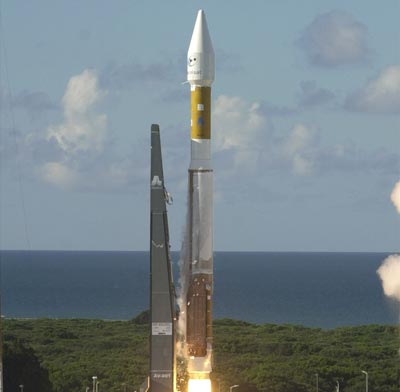US space launch policy: security versus expenseby Taylor Dinerman
|
| The commercial space launch market has stagnated and no one can predict when, or if, it will pick up again. |
The US government is going to be buying these rockets for a long time to come. For the military alone, more than 50 launches will have to be bought within the next ten years. NASA and NOAA will also be buying some of these vehicles for their own needs. The question is not really, “Should we keep both production lines open in the short run?” but, “What should be the policy ten or fifteen years from now when NASA’s Crew Exploration Vehicle is operational and the shuttle is retired?” Does the US government really want to be faced with a situation in which the US is denied access to space for years on end while contractors spend tens, or hundreds, of millions trying to fix a broken launch system? The time and effort it took to recover from the disasters of the late 1980s should be a warning.
At some point, probably in about twenty years time, the EELVs will have to be replaced as the primary military launch systems. What kind of a replacement, how much will it cost and how responsive will it be are all still open questions. The nature of the requirements will be set by the size and mission of the Pentagon’s future spacecraft. Will these be the small and relatively low cost satellites, such as those that were originally promised for the Future Imagery Architecture program? Swarms of small surveillance satellites could, in the future, provide for the persistence that both the theater commanders and the national intelligence community say they want, but they could be less than adequate if they end up costing more than estimated and if their performance is not as good as what the intelligence community gets from the current generation of spacecraft.
One alternative would be large scale gossamer structures in medium Earth orbit (MEO) or in geosynchronous orbit (GEO). Very large lightweight apertures, such as those described by Ivan Bekey, in his book Advanced Space System Concepts, could be chosen as being both persistent and being above the altitude that would make them vulnerable to primitive anti satellite weapons.
| Does the US government really want to be faced with a situation in which the US is denied access to space for years on end while contractors spend tens, or hundreds, of millions trying to fix a broken launch system? |
Similar considerations apply to communications, eavesdropping, navigation and weather satellites. Deciding what the shape and nature of America’s military space fleet will be over the next thirty years, is more of an art than a science. General Moorman, now retired and working for the consultancy Booz Allen Hamilton, has been asked to “relook at the launch business.” This is going to be an exceptionally difficult study to get right. Estimating launch rates ten years from now is moderately hard; trying to prophesize what things will be like twenty years or more from now is exceptionally hard.
Some civilian factors include: Will there be a renaissance of communications satellites due to developments in laser communications technology? Will there be a stronger demand for commercial remote sensing satellites? Will there be regular tourist flights to orbit? Military factors that Moorman and his team will have to examine are: Will the US place anti-missile defense systems in orbit? What will be the requirements for offensive and defensive counterspace systems? There will also be other questions related to the so-called weaponization of space.
General Moorman’s report is due in December. Like the Rumsfeld Commission report four years ago, it will probably be the basis for a discussion of future military space policy, no matter who wins. Four years ago, the Rumsfeld Commission alerted the incoming administration to some serious problems with the internal organization of the US military space effort. One hopes that this new report will make it clear that a difficult set of decisions will have to be made over the next four years. These choices will not only determine the size of US space forces over the next thirty or more years, but could decide whether or not the US remains the number one military power on this planet.
